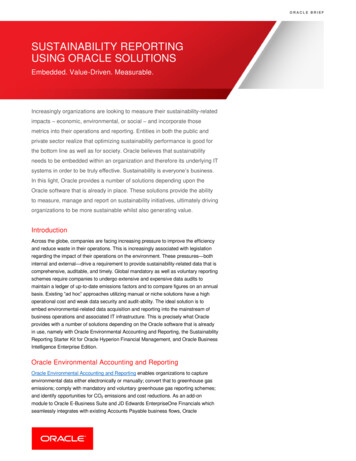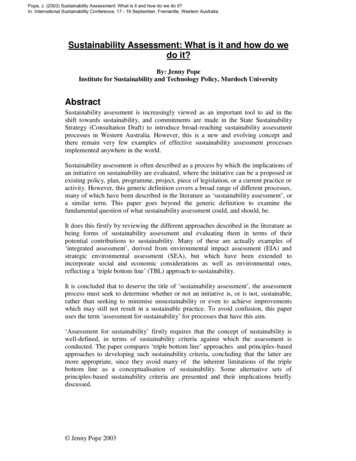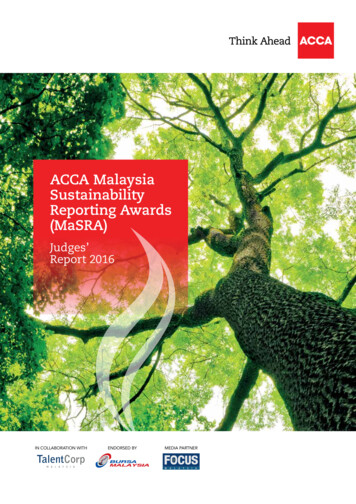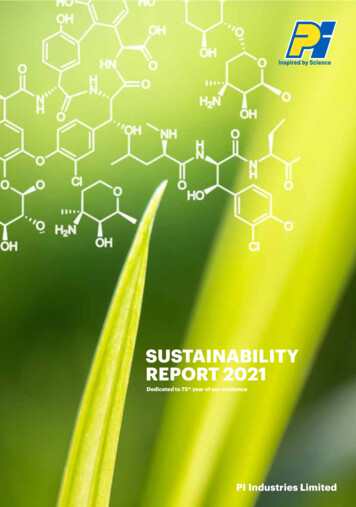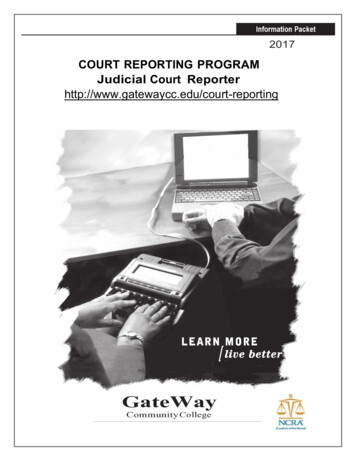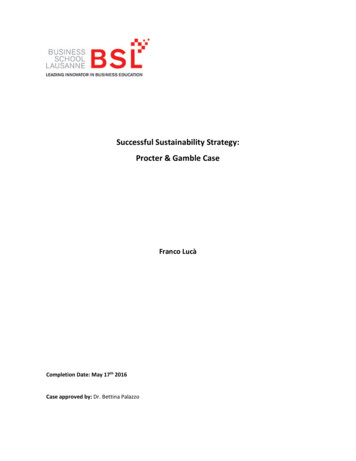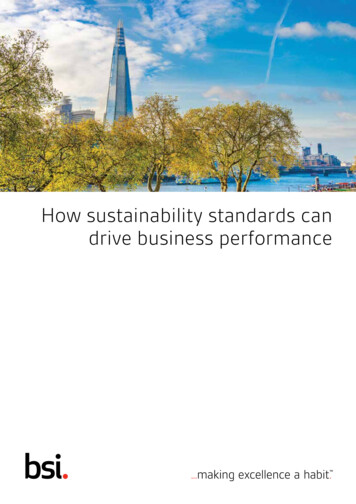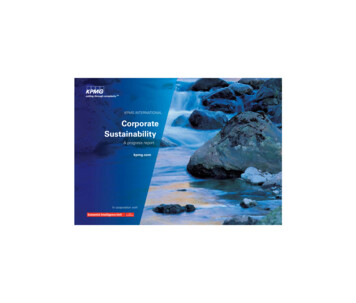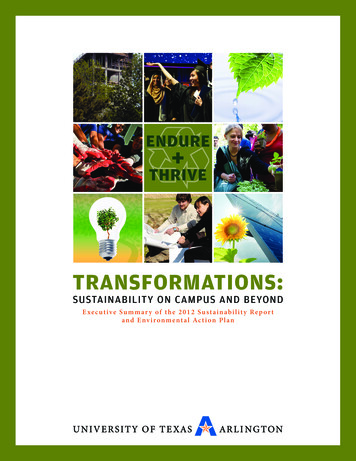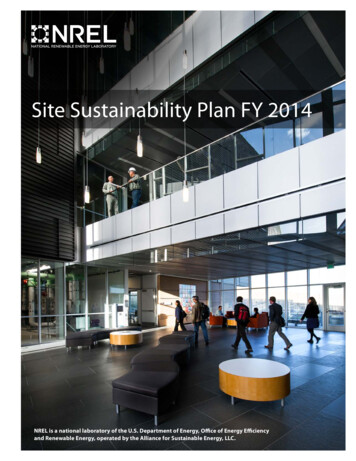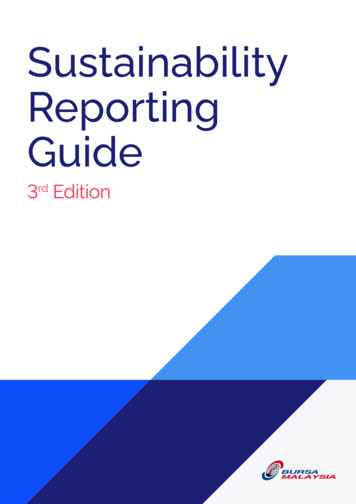
Transcription
SustainabilityReportingGuide3rd EditionCreated for you by:BursaMalaysia.com
#beSUSTAINABLEDISCLAIMER:This Sustainability Reporting Guide (“Guide”) is issued by Bursa Malaysia SecuritiesBerhad to, among others, assist listed issuers in preparing the SustainabilityStatement as required under the Listing Requirements of Bursa Malaysia SecuritiesBerhad [paragraph 9.45(2) and paragraph (29), Part A of Appendix 9C of the MainMarket Listing Requirements (supplemented by Practice Note 9) and paragraph(30) of Appendix 9C of the ACE Market Listing Requirements (supplemented byGuidance Note 11)].While this Guide is intended to provide the relevant information and guidance forlisted issuers to prepare their Sustainability Statement, it may not be exhaustive inits coverage. Listed issuers must exercise discernment and diligence when usingthis Guide. All applicable laws, regulations and existing Listing Requirements ofBursa Malaysia Securities Berhad should be referred to in conjunction with thisGuide.Although care has been taken to present current and pertinent information inthis Guide, Bursa Malaysia Securities Berhad does not make any representationor warranty, whether implied or expressed, as to the accuracy, completeness orreliability of the contents of this Guide.In no event shall Bursa Malaysia Securities Berhad be liable for any decisionsmade on the basis of the information in this Guide or any other claim, howsoeverarising, out of or in relation to this Guide. Bursa Malaysia Securities shall underno circumstances be liable for any type of damages including but not limited to,direct, indirect, special, consequential, incidental, or punitive damages whatsoeveror any lost profits or lost opportunities.All rights reserved. The Bursa Malaysia name and logo are registered trademarks.
#beSUSTAINABLETABLE OFCONTENTSAbout this Guide2Background to Bursa Malaysia’s Sustainability Reporting Requirements6Sustainability Governance11Scope and Basis of Scope20Materiality Assessment29Management Approach56Measurement Methodologies for Indicators71Performance Targets118Performance Data Table129Statement of Assurance135TCFD-aligned Disclosures143List of Disclosure Guidance(s)148
#beSUSTAINABLEChapter12345678910 11Chapter 1:About this Guide1.PurposeThis Sustainability Reporting Guide (“Guide”) details the business case for embedding sustainabilityand provides guidance on how this can be achieved. It also provides specific guidance on theinformation that should be disclosed when producing a Sustainability Statement in the Annual Reportin accordance with Bursa Malaysia’s Listing Requirements (“LR”).2. ObjectivesThis Guide seeks to help companies to:a) appreciate how sustainability can facilitate, support and drive corporate and societal value;b) improve awareness of the relevant risks and opportunities connected to the company’ssustainability matters or issues;c) identify, prioritise and manage material sustainability matters so that companies can focus onwhat is important to its stakeholders, and in turn, create long term value to stakeholders andsociety at large; andd) improve the quality and depth of sustainability information disclosed to better serve the needsand expectations of users of sustainability information.3. Users of this GuideThis Guide is intended for all listed issuers (“companies”) on Bursa Malaysia’s Main and ACE Markets.Companies are strongly encouraged to refer to this Guide in the course of preparing their respectiveSustainability Statements.The Guide has been developed in recognition of the fact that companies may be at different stages oftheir sustainability journey and preparing the Sustainability Statement can be challenging especiallyfor early reporters or smaller listed companies. Essentially, the contents of the Guide are applicable tocompanies at all levels of understanding and sophistication, be it in terms of sustainability disclosuresor the underlying practices that facilitate such disclosures. Each company is encouraged to apply thisGuide bearing in mind their own circumstances and in the context of their business operations (i.e.resources, experience, expertise and understanding).In addition to reporting against Bursa Malaysia’s Sustainability Reporting Framework and theRecommendations of the Task Force on Climate-related Financial Disclosures (“TCFD”), companiesare further encouraged to report in alignment with or, with adherence to, international sustainabilityreporting frameworks or guidelines such as the Global Reporting Initiative (“GRI”) Standards, theSustainability Accounting Standards Board (“SASB”) Standards, and the FTSE Russell FTSE4GoodCriteria. Other authoritative sources of reference include any standards issued by, among others, theInternational Sustainability Standards Board (“ISSB”) and the European Union’s European FinancialReporting Advisory Group (“EFRAG”) and the Recommendations of the Taskforce on Nature-relatedFinancial Disclosures (“TNFD”).2
#beSUSTAINABLEChapter12345678910 11For further support on embedding sustainability in companies, the Exchange also offers variousresources including (but not limited to):a) Bursa Malaysia’s Sustainability Toolkits (“Toolkits”);b) additional guidance documents; andc) best practice approaches, case studies, example disclosures and matrices, accessible viaBursa Sustain; an online one-stop knowledge portal to promote and support development in theareas of corporate governance, sustainability and responsible investment for listed companies,investors and other stakeholders.This Guide specifically focuses on guiding companies with their sustainability reporting anddisclosures. Any relevant content, supplemental sources of information and examples are to be readas non-exhaustive.A Quick Tour of the GuideThe following terms are used throughout the chapters in the Guide:Listing RequirementsListing Requirements are provided in eachchapter of the Guide and are categorisedaccording to requirements for both theMain Market and ACE Market.DefinitionsWhere relevant, definitions are providedfor terminologies that are used throughoutthe Guide to aid user understanding.DefinitionsSustainability governance structure is defined as the structure a company has in place to ensureaccountability, oversight and review in the identification and management of sustainability matters(i.e. roles and responsibilities of those in charge of the company’s sustainability performance anddisclosures).Oversight is defined as having the responsibility to oversee the development and implementationof strategies including sustainability strategies, business plans and key initiatives to ensure thedesired sustainability outcomes. This usually comes from the highest level of governing bodywithin a company.Strategic management is defined as the management of a company’s resources by planning,setting and evaluating relevant strategies while analysing the company’s business environmentto ensure its sustainability goals and targets are met and the impacts of sustainability risks andopportunities are managed.Day-to-day implementation is defined as the daily tasks to ensure effective implementation of thecompany’s sustainability strategies and plans.Disclosure GuidanceIn each chapter, a series of DisclosureGuidance(s)areprovidedtoaidcompanies in addressing Bursa Malaysia’ssustainability-related Listing Requirements.Each Disclosure Guidance is supplementedwith key questions that companies shouldaddress in their Sustainability Statements.Disclosure Guidance 1:Oversight of sustainability mattersQuestion: Who is responsible for the oversight of the company’s material sustainability matters?Question: What is the nature of oversight performed?Disclosure Guidance 2:Strategic management of sustainability mattersQuestion: Who is responsible for the strategic management of the company’s material sustainabilitymatters?Question: What is the nature of the strategic management performed?3
#beSUSTAINABLEChapter12345678910 11A Quick Tour of the Guide (cont’d)The following terms are used throughout the chapters in the Guide (cont’d):Levels of proficiencyBeginner, Intermediate, AdvancedWhere relevant, guidance is providedfor companies to improve on theirsustainability reporting in a phased manner.Case StudiesWhere relevant, Disclosure Guidance(s)are supplemented with selected casestudies throughout the Guide.Case study 1In its Sustainability Report 2021, SDP provided a diagram of its sustainabilitygovernance structure and disclosed the roles and responsibilities, as well asthe inter-relationships of various sustainability governance positions within thecompany. The party responsible for sustainability oversight and the actions takenby them to perform sustainability oversight are highlighted.Sime DarbyPlantationBerhad(“SDP”)“The Board takes an active role in looking into climate change, conservationand biodiversity, human rights, supply chain amongst other sustainabilityrelated matters of the Group through the Board Sustainability Committee(BSC). The BSC supports the Board’s oversight of the Group’s sustainabilityobjectives, policies, and practices”Source: Sime Darby Plantation Berhad Sustainability Report 2021ToolkitsCross references are provided tothe relevant Toolkits. Companies areencouraged to read the Guide togetherwith the corresponding Toolkits.Additional ResourcesWhere relevant, a list of supplementaryresources are provided to companies foreasy reference.ToolkitsFor additional information on sustainability governance, please refer to the Toolkit:Governance.Additional ResourcesThe following are supplementary resources for this chapter:Securities Commission Malaysia’s Malaysian Code on Corporate nload.ashx?id 239e5ea1-a258-4db8a9e2-41c215bdb776Bursa Malaysia Corporate Governance Guide (4th ports/Binder-Bursa-CG-Guide.pdfBursa Malaysia PLC Transformation (PLCT) Programme Guidebook 09 BURSA Book 2 Sustainable SociallyResponsible and Ethical PLCs vF.pdf4
#beSUSTAINABLEChapter12345678910 11A Quick Tour of the Guide (cont’d)The following terms are used throughout the chapters in the Guide (cont’d):List of Disclosure Guidance(s)At the end of the Guide, a list of all thedisclosure guidance(s) and correspondingquestions are provided for easy reference.ChapterDisclosure GuidanceQuestionsChapter 3:SustainabilityGovernanceDisclosure Guidance 1:Oversight ofsustainability mattersWho is responsible for the oversight ofthe company's material sustainabilitymatters?page 13What is the nature of oversightperformed?page 13Who is responsible for the strategicmanagement of the company's materialsustainability matters?page 14What is the nature of strategicmanagement performed?page 14Who performs/implementssustainability-related tasks and initiativeson a day-to-day basis?page 16Disclosure Guidance 2:Strategic managementof sustainability mattersDisclosure Guidance 3:Day-to-dayimplementation ofsustainability mattersPageNumber[The rest of the page has been intentionally left blank.]5
#beSUSTAINABLEChapter12345678910 11Chapter 2:Background to BursaMalaysia’s SustainabilityReporting RequirementsDevelopments in the international sustainability ecosystemIn recent years, there has been tremendous development and growth across the sustainabilityecosystem worldwide. This is largely driven by ever increasing demands from various stakeholders (e.g.institutional investors, lenders, customers, non-governmental organisations (“NGOs”) and regulators) forbetter sustainability or environmental, social and governance (“ESG”)1 practices as well as disclosures bybusinesses. For instance, signatories to the United Nations Principles of Responsible Investment (“UNPRI”) with a combined USD121.3 trillion assets under management (as at 2021) would avoid investing incompanies that do not embrace good ESG practices.Apart from mounting stakeholder pressure, the COVID-19 pandemic has brought to light the ramificationsof poorly managed sustainability risks to overall business resilience and economic growth. Specifically,supply chain disruptions as well as limited natural and human capital resources have translated to lostproductivity and increased cost of doing business. Furthermore, companies also need to contend withother pressing sustainability issues such as climate change, biodiversity loss, pollution and human rights.Separately, the European Commission is proposing the implementation of a Carbon Border AdjustmentMechanism (“CBAM”)2 to prevent the risk of carbon leakage and support the European Union’s increasedambition on climate mitigation. A simplified CBAM system will be implemented from 2023 for selectedproducts with the definitive system targeted to be fully operational in 2026. Operationally, the CBAM willimpact all businesses with carbon-intensive processes that are selling to, or are supplying, entities withinthe European Union regardless of size and maturity in ESG practices. As Malaysia is a trading nation withsignificant trade relations with the European Union, many Malaysian businesses that form parts of globalsupply chains (including public listed companies) would undoubtedly be impacted by this development.When taken as a whole, it is imperative that companies manage their economic, environmental and socialimpacts well to enhance business resilience and performance.Developments in the Malaysian sustainability ecosystemAlong the same vein, there have also been several key developments in Malaysia that aptly reflect theheightening demand for good sustainability practices and disclosures in recent years. For instance, withthe adoption of the whole-of-nation approach in the implementation of the 12th Malaysia Plan (coveringthe 2021-2025 period), both the public and private sectors are expected to embrace good ESG principles126The terms EES (economic, environmental and social) and ESG (environmental, social and governance) are not clearly differentiated and oftenused interchangeably. We acknowledge that governance is an important part of sustainability. For the purposes of this Guide, our focus islargely on EES only because the “G” - governance element has already been extensively covered elsewhere under the existing disclosurerequirements in the Listing Requirements and the Malaysian Code on Corporate Governance.For more information, please see:(a) CBAM background: on-0/carbon-border-adjustment-mechanism en(b) CBAM Q&A: /en/qanda 21 3661
#beSUSTAINABLEChapter12345678910 11in their decision-making and processes. Furthermore, the Plan is closely aligned to the United Nation’sSustainable Development Goals (“SDGs”). Consequently, Board of Directors (“Boards”) are expected tounderstand the sustainability issues relevant to the company and its business, including climate-relatedrisks and opportunities.On a related front, institutional investors, in particular members of Institutional Investors Council Malaysia(“IIC”), are also collectively championing for better ESG practices as well as disclosures by their investeecompanies. In a clear sign of commitment, some IIC members have become signatories of the UN PRIincluding the Employees Provident Fund (“EPF”) and Retirement Fund Incorporated (“KWAP”). In addition,institutional investors such as the EPF3, Permodalan Nasional Berhad4 and Khazanah Nasional5 announcedsustainability investment policies/frameworks and commitments toward ESG-compliant and/or climateneutral/net zero portfolios.In response to the urgent need to expedite and ensure a smooth and orderly transition to a lowcarbon economy, Bank Negara Malaysia and the Securities Commission Malaysia established the JointCommittee on Climate Change (“JC3”)6 platform in September 2019 to pursue collaborative actions inbuilding climate resilience across the Malaysian financial sector. The initiatives by JC3 have also beeninstrumental in improving the preparedness of the financial sector in managing impacts of climate changewhile supporting the transition towards a low carbon economy. It is worth noting that members of JC3 aresupportive of mandating TCFD-aligned disclosures from 2024.Against the abovementioned backdrop, companies will need to devote dedicated attention to the variousimpacts of sustainability, and more urgently, associated risks and opportunities arising from climatechange. This should be coupled with similarly insightful disclosures to facilitate assessment by key capitalmarket stakeholders (including investors, banks, insurers and asset managers).Sustainability Reporting: Developments in the international arenaIn terms of developments in the international sustainability reporting arena, we have also observedsignificant advancements. Many influential international sustainability reporting standard setters haveeither issued or are currently enhancing their respective standards or frameworks. The GRI7, for example,has revised their Universal Standards (“Universal Standards 2021”) to, among others, fully reflect duediligence expectations for organisations to manage their sustainability impacts, including on humanrights, as set forth in intergovernmental instruments by the UN and the Organisation for EconomicCo-operation and Development (“OECD”). New players such as the International Financial ReportingStandards (“IFRS”) Foundation have also entered the ecosystem with the aim of developing a globallyaccepted set of sustainability reporting standards via the launch of the ISSB. The IFRS Foundation hasalso consolidated with the Climate Disclosure Standards Board (“CDSB”) in March 2022 and with theValue Reporting Foundation (“VRF”) in August 2022.34567For more information, please see https://www.kwsp.gov.my/sustainable-investment#: :text cesses%20and%20stakeholder%20engagement.For more information, please see ion-for-green-transition/#: :text rbon%2Dneutral%20ambition.%E2%80%9D&text by%202030.For more information, please see https://www.khazanah.com.my/news press kand-targets/.Members of the JC3 comprise of the Exchange and 19 financial industry players as well as relevant experts. For more information, pleasesee https://www.bnm.gov.my/climatechange.For more information, please see -human-rights-reporting/.7
#beSUSTAINABLEChapter12345678910 11Anchored within these developments is a call for better availability, comparability and an overall improvedquality of sustainability disclosures. These are facilitated via the convergence of various internationalsustainability reporting frameworks/standards and an increasing demand for sustainability disclosuresto be subjected to robust assurance processes.Sustainability Reporting: MalaysiaThe sustainability reporting ecosystem in Malaysia has seen considerable growth in the past decade, froma largely nascent stage to one where all listed issuers are undertaking sustainability-related initiatives aswell as producing Sustainability Statements or Reports on an annual basis. Bursa Malaysia’s SustainabilityReporting Framework (“Framework”) played a pioneering and pivotal role in terms of spurring the evolutionof the ecosystem. More specifically, the Framework was launched in 2015, consisting of the following:a) the requirement under the LR for a listed issuer to provide a narrative statement on the managementof material economic, environmental and social (“EES”) risks and opportunities in their annual reports(“Sustainability Statement”);b) the Sustainability Reporting Guide (“Guide”); andc) the Toolkits.In 2018, the Sustainability Reporting Guide and Toolkits were updated to include more current casestudies, references to the SDGs and the TCFD Recommendations and a new chapter on assurance toprovide guidance on how it may be conducted.In 2022, the Exchange significantly enhanced its Framework by:a) requiring the disclosure of prescribed sustainability matters and indicators that are deemed materialfor listed issuers across all sectors (“common sustainability matters and common indicators”);b) mandating climate change-related disclosures in line with the TCFD Recommendations for MainMarket listed issuers and mandating the disclosure of a basic plan to transition towards a low-carboneconomy for ACE Market listed corporations;c) enhancing disclosure of quantitative information by requiring the disclosure of at least 3 financialyears’ data in respect of reported indicators, performance target(s) if set by the listed issuer and asummary of the same information in a prescribed format; andd) requiring a statement on whether the sustainability statement has been assured and if so, the subjectmatter(s) and scope covered. In addition, if independence assurance is undertaken, the conclusionmust also be disclosed.The Guide and corresponding Toolkits have since been revised to provide guidance with regards to theseenhancements.8
#beSUSTAINABLEChapter12345678910 11For disclosures on publishing a Sustainability Statement, the LR is as follows:Listing RequirementsParagraph 29, Part A of Appendix 9C, Main Market Listing Requirements8Contents of annual report(29) A narrative statement of the listed issuer’s management of material economic,environmental and social risks and opportunities (“Sustainability Statement”), in themanner as prescribed by the Exchange.Paragraph 6.1, Practice Note 9, Main Market Listing Requirements9All listed issuers should ensure that the Sustainability Statement contains information thatis balanced, comparable and meaningful by referring to the Sustainability Reporting Guideissued by the Exchange. In identifying the material economic, environmental and social risksand opportunities, the listed issuer should consider the themes set out in the SustainabilityReporting Guide.Paragraph 30, Part A of Appendix 9C, ACE Market Listing Requirements10Contents of annual report(30) A narrative statement of the listed corporation’s management of material economic,environmental and social risks and opportunities (“Sustainability Statement”), in themanner as prescribed by the Exchange.Paragraph 6.1, Guidance Note 11, ACE Market Listing Requirements11All listed corporations should ensure that the Sustainability Statement contains informationthat is balanced, comparable and meaningful by referring to the Sustainability ReportingGuide issued by the Exchange. In identifying the material economic, environmental andsocial risks and opportunities, the listed corporation should consider the themes set out inthe Sustainability Reporting Guide.In line with widely-accepted principles or conventions of good reporting practice, SustainabilityStatements must contain information that is:a) balanced; andb) comparable and meaningful.These terms are explored in turn below.891011Bursa Malaysia Securities Berhad, Paragraph 29, Part A of Appendix 9C, Main Market Listing RequirementsBursa Malaysia Securities Berhad, Practice Note 9, Risk Management and Internal Control, Corporate Governance and SustainabilityStatementBursa Malaysia Securities Berhad, Paragraph 30, Part A of Appendix 9C, ACE Market Listing RequirementsBursa Malaysia Securities Berhad, Guidance Note 11, Risk Management and Internal Control, Corporate Governance and SustainabilityStatement9
#beSUSTAINABLEChapter1.12345678910 11Balanced12 disclosuresThe principle of “balance”, requires that companies report information in an unbiased manner andprovide a fair representation of the company’s positive and negative impacts.In particular, companies should: present information in a way that allows information users to see negative and positive year-onyear trends in impacts;distinguish clearly between facts and the company’s interpretation of the facts;not omit relevant information concerning its negative impacts;not overemphasise positive news or impacts; andnot present information in a way that is likely to inappropriately influence the conclusions orassessments of information users.2. Comparable and meaningful disclosuresComparable and meaningful disclosures facilitate the analysis of changes in a company’s impactsover time, and in relation to those of other companies.In particular, to enhance comparability13, companies should: present information for the current reporting period and at least two previous reporting periods,as well as any goals and targets that have been set;use accepted international metrics (e.g., kilograms, litres), and standard conversion factors andprotocols, where applicable, for compiling and reporting information;maintain consistency in the methods used to measure and calculate data and in explaining themethods and assumptions used;maintain consistency in the manner of presenting the information;report total numbers or absolute data (e.g., metric tons of CO2 equivalent) as well as ratios ornormalised data (e.g., CO2 emissions per unit produced) to enable comparisons, and provideexplanatory notes when using ratios;provide contextual information (e.g., the company’s size, geographic location) to help usersunderstand the factors that contribute to differences between the company’s impacts and theimpacts of other companies;present the current disclosures alongside restatements of historical data to enable comparisonsif there have been changes from the information reported previously. This can include changes inthe length of the reporting period, in the measurement methodologies, in the definitions used, orin other elements of reporting; andif restatements of historical data are provided, explain the changes to provide contextualinformation for interpreting the current disclosures.These characteristics are critical in enabling stakeholders to form an objective opinion of the company’ssustainability practices and disclosures. For more detailed guidance on how to address the more specificsustainability reporting-related Listing Requirements, please refer to the subsequent chapters in this Guide.1213As per the GRI StandardsAs per the GRI Standards10
#beSUSTAINABLEChapter12345678910 11Chapter 3:Sustainability GovernanceAs mentioned in Chapter 2, there have been increasing expectations from external stakeholders (e.g.institutional investors, lenders and customers) for companies to provide pertinent disclosures on theirmanagement of material sustainability matters. One critical component is the sustainability governancestructure put in place to create a line of accountability for sustainability including the relevant governingbodies and/or functions established, division of roles and responsibilities as well as lines of reporting.DefinitionsSustainability governance structure is defined as the structure a company has in place to ensureaccountability, oversight and review in the identification and management of sustainability matters(i.e. roles and responsibilities of those in charge of the company’s sustainability performance anddisclosures).Oversight is defined as having the responsibility to oversee the development and implementationof strategies including sustainability strategies, business plans and key initiatives to ensure thedesired sustainability outcomes. This usually comes from the highest level of governing body withina company.Strategic management is defined as the management of a company’s resources by planning,setting and evaluating relevant strategies while analysing the company’s business environmentto ensure its sustainability goals and targets are met and the impacts of sustainability risks andopportunities are managed.Day-to-day implementation is defined as the daily tasks to ensure effective implementation of thecompany’s sustainability strategies and plans.11
#beSUSTAINABLEChapter12345678910 11For disclosures on sustainability governance, the LR is as follows:Listing RequirementsParagraph 6.2, Practice Note 9, Main Market Listing Requirements14In making the Sustainability Statement, a listed issuer must include disclosures on thefollowing:(a) the governance structure in place to manage the economic, environmental and socialrisks and opportunities (“sustainability matters”);Paragraph 6.2, Guidance Note 11, ACE Market Listing Requirements15In making the Sustainability Statement, a listed corporation must include disclosures on thefollowing:(a) the governance structure in place to manage the economic, environmental and socialrisks and opportunities (“sustainability matters”);There is no standard one-size-fits-all approach to sustainability governance. A company’s culture, needs,sector, size, sustainability-related risks and opportunities, and maturity in responding to sustainabilitymatters, will influence how sustainability governance is performed. Given this, each company isencouraged to adopt an approach that best fits its distinctive operating context.In this chapter, ‘Disclosure Guidance’ sections address the following:1.Oversight of sustainability matters2.Strategic management of sustainability matters3.Day-to-day implementation of sustainability matters141512Bursa Malaysia Securities Berhad, Practice Note 9, Risk Management and Internal Control, Corporate Governance and SustainabilityStatementBursa Malaysia Securities Berhad, Guidance Note 11, Risk Management and Internal Control, Corporate Governance and SustainabilityStatement
#beSUSTAINABLEChapter12345678910 11Disclosure Guidance 1:Oversight of sustainability mattersQuestion: Who is responsible for the oversight of the company’s material sustainability matters?Question: What is the na
easy reference. CASe STUDy 1 Sime Darby Plantation Berhad ("SDP") In its Sustainability Report 2021, SDP provided a diagram of its sustainability governance structure and disclosed the roles and responsibilities, as well as the inter-relationships of various sustainability governance positions within the company.
